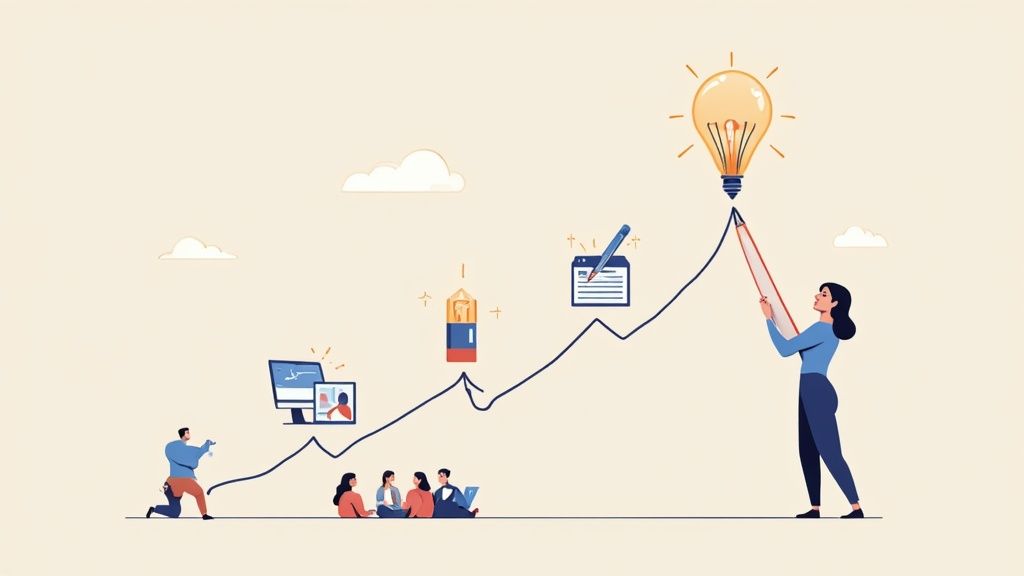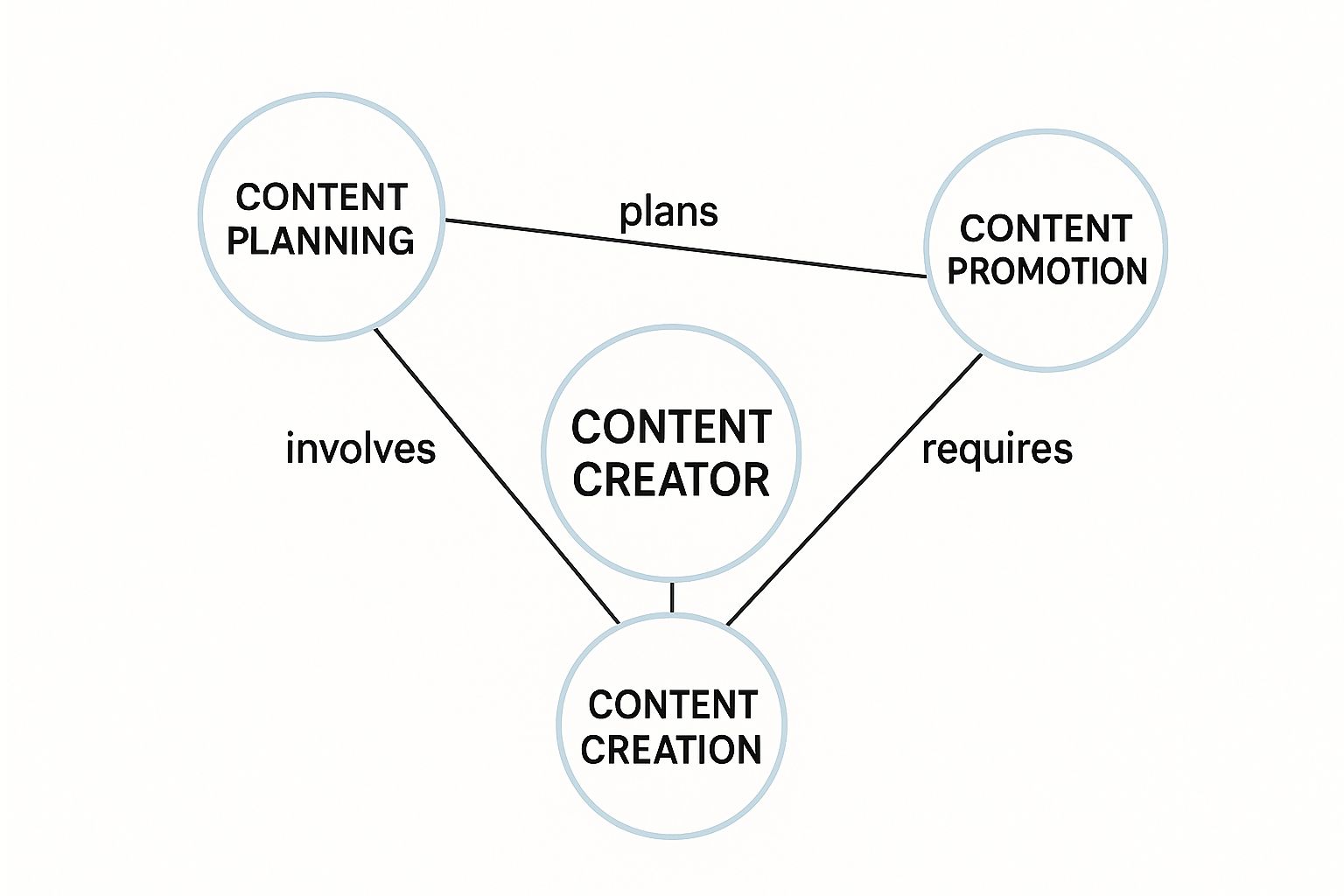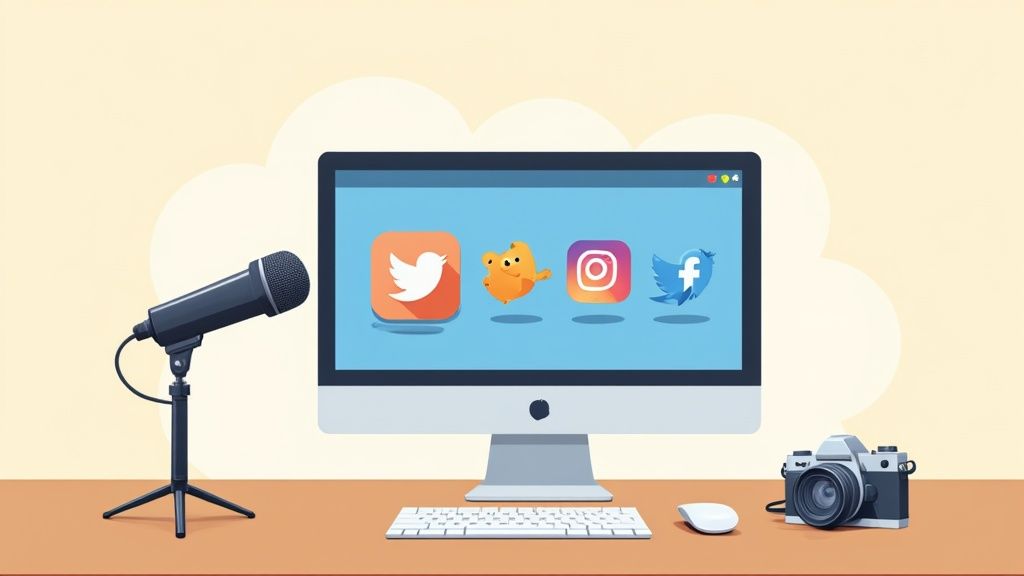
Content Creator Job Description: Tips for Hiring Success
Published
Decoding the Modern Content Creator Role

Imagine trying to explain email to someone who's only ever written letters by hand. That's kind of what it's like trying to define the constantly shifting landscape of the content creator role. It's not just about posting on social media anymore; it's a strategic position that blends creativity, technical know-how, and sharp business sense. The content creator job description has expanded to cover a huge range of responsibilities, reflecting how crucial content has become for businesses today.
This evolution has led to a massive increase in content creators around the world. There are now over 64 million YouTube content creators, and more than 165 million creators have joined social media platforms since 2020. For a deeper dive into these numbers, check out this compilation of content creator statistics.
Beyond the "Post and Pray" Approach
Forget the old "post and pray" method. Content creation today is a data-driven discipline. Modern content creators are expected to understand analytics, track key performance indicators (KPIs), and use data insights to refine their strategies. This means the ideal candidate is comfortable analyzing data and letting those insights guide their creative decisions. This data-focused approach is essential for maximizing a campaign's impact and showing a real return on investment (ROI).
The Three Core Types of Content Creators
While every content creator job description is different, most roles tend to fall into three main categories:
Brand Storytellers: These creators weave compelling narratives that resonate with the target audience and build a strong brand identity. Think of them as the poets of the brand, using words and visuals to create emotional connections with consumers.
Community Builders: These creators focus on audience engagement and fostering a sense of community around the brand. They're the social butterflies, initiating conversations, responding to comments, and nurturing relationships that turn followers into loyal fans. If you're curious about a related field, take a look at this guide on the Influencer Marketing Manager job description.
Growth Drivers: These creators are all about measurable results. They use content to generate leads, boost conversions, and ultimately drive business growth. They're the strategists, constantly analyzing data, experimenting with different content formats, and optimizing for maximum impact. As your team expands, you'll need effective ways to scale content creation.
Understanding these distinct types of content creators is essential for writing effective job descriptions and building a high-performing content team. Each type brings a unique skillset and strengths to the table, contributing to the overall success of your content strategy.
What Content Creators Actually Do All Day

This infographic gives us a visual snapshot of a content creator's core responsibilities, showing how content planning, creation, and promotion all work together. Notice how these tasks are cyclical, not linear. Planning shapes what gets created, creation fuels the promotion process, and the results of promotion provide valuable feedback for future planning. It's a continuous loop of improvement.
So, what does a typical day look like for someone with a content creator job description? It's not all spontaneous bursts of inspiration (though those are nice!). It's more about having a structured approach to engaging an audience. Think of it like running a small business. You need a solid business plan (your content strategy), a production line (content creation), and a way to reach your customers (content promotion).
Content Planning: The Foundation of Success
Content creation doesn't start with a blank page. It starts with a plan. Just as an architect drafts blueprints before laying the first brick, content creators map out their content calendar. This involves researching trending topics, analyzing audience insights, and making sure their content aligns with overall marketing goals. This strategic planning is the foundation for creating content that truly resonates and performs well.
Content Creation: Bringing Ideas to Life
This is where the "magic" happens—transforming ideas into engaging content. But even this "magic" relies on process and best practices. A content creator job description often includes tasks like writing blog posts, scripting videos, designing infographics, or capturing compelling photos. This stage blends creative thinking with technical skill, requiring proficiency in different software and platforms. For instance, a video creator needs to master video editing software like Adobe Premiere Pro or Final Cut Pro, while a writer might use tools like Grammarly for polishing their work.
Content Promotion: Amplifying Your Reach
Creating great content is just the first step. It also needs to reach the right audience. Content promotion is all about strategically sharing and distributing your content across various channels. Think social media marketing on platforms like Facebook or Instagram, email campaigns using services like Mailchimp, influencer collaborations, or even paid advertising. Engaging with the audience through comments and community forums is also a key part of promotion. This builds connections, fosters loyalty, and turns viewers into engaged followers and brand advocates.
To understand the different facets of a content creator's role, let's look at the following table. It breaks down daily tasks versus long-term strategic responsibilities.
Daily vs. Strategic Content Creator Responsibilities
A comparison of day-to-day tasks versus long-term strategic responsibilities in content creator roles.
| Daily Tasks | Strategic Responsibilities | Time Allocation | Impact Level |
|---|---|---|---|
| Creating social media posts, responding to comments, scheduling content | Developing a content strategy, analyzing audience data, setting campaign goals | 30-40% | Short-term engagement, community building |
| Writing blog posts, creating graphics, editing videos | Keyword research, SEO optimization, content calendar planning | 40-50% | Medium-term traffic generation, brand awareness |
| Monitoring analytics, tracking performance, reporting results | Evaluating campaign effectiveness, adjusting strategy, exploring new content formats | 20-30% | Long-term brand growth, audience loyalty |
This table highlights how content creators balance their day-to-day activities with bigger-picture thinking. While creating engaging content for immediate consumption is crucial, the strategic planning and analysis ensure long-term success and sustainable growth.
Skills That Separate Great Creators From Good Ones

Content creator job descriptions often mention "creativity." But what does that really mean? It's a bit like saying someone is "good at sports"—it tells you almost nothing about their actual abilities. Truly successful content creators have a special blend of artistic vision and analytical thinking. They're equal parts dreamer and data analyst.
Mastering the Technical Toolkit
Technical skills are undeniably important. Knowing your software is a must. Video creators need to be fluent in their editing software, writers need a strong grasp of grammar and style, and graphic designers need expertise in tools like Adobe Photoshop and Illustrator.
Also, understanding how platform algorithms work is key to getting your content seen. For example, knowing how to automate social media posts through tools like Postiz can free up a creator's time to focus on the creative aspects of their work. This efficiency is crucial for long-term success.
The Soft Skills That Drive Success
But here's the thing: the most impactful skills often get left out of job descriptions. These are the soft skills that elevate a creator from good to great. Let's explore a few:
Pattern Recognition: Imagine a trend forecaster in the fashion industry. The best creators have a similar ability to spot emerging trends. They deeply understand their audience and can anticipate what will resonate.
Storytelling: Great creators are natural storytellers. They can weave captivating narratives that resonate with audiences on an emotional level. Think about how a skilled novelist draws you into their world – the best content creators do the same.
Emotional Intelligence: This is the magic ingredient. The top creators understand how to connect with their audience authentically. They build trust and nurture a sense of community around their content. It's about understanding the human element behind the screen.
Evaluating Portfolio Quality
When you look at a creator's portfolio, don't just focus on how pretty it looks. While aesthetics are important, a truly strong portfolio demonstrates impact. Look for evidence of audience engagement, measurable results, and a deep understanding of the target audience.
A portfolio should showcase not just what a creator can do, but what they have done and the results they've achieved. This reveals their strategic thinking – a crucial aspect of any content creation role. It's about showing, not just telling.
The Business Reality Behind Content Creation Careers

Let's have an honest conversation about content creation as a career path. While social media often showcases the glamorous side, the day-to-day reality for many creators involves unpredictable income, the risk of burnout, and the constant pressure to produce engaging content. This significantly impacts how we should approach a content creator job description, requiring a grounded understanding of the field.
The Feast-or-Famine Cycle
Imagine a musician who relies solely on income from gigs. Some months are financially rewarding, while others can be quite lean. Many content creators experience a similar pattern of unpredictable income, particularly freelancers or those dependent on platform ad revenue. A viral video might bring a sudden influx of cash, but maintaining that momentum is a real challenge. This income volatility is a critical factor to consider when structuring compensation within a content creator job description.
The Burnout Factor
The nature of content creation demands a constant flow of new material. This can quickly lead to creative burnout, especially when coupled with the pressure to stay relevant and keep audiences engaged. Think of a chef who has to constantly invent new dishes – eventually, their inspiration will likely wane. Content creators, like chefs, require time to recharge and prevent the exhaustion that stems from perpetually generating fresh ideas.
The Entrepreneurial Mindset
Many successful content creators diversify their income streams through various avenues. These can include sponsorships, merchandise, affiliate marketing, and even creating their own products or services. This entrepreneurial spirit is often vital for navigating the creator economy. This inherent drive significantly influences how creators perceive traditional employment, shaping the type of content creator job description that will resonate with them. For instance, they may prioritize flexibility and creative control over a higher base salary. It's worth noting that the creator economy itself is experiencing explosive growth, projected to reach a staggering $1.49 trillion by 2034, up from a $250 billion valuation in 2024, representing a 26.4% annual growth rate. To learn more about this remarkable growth, check out these creator economy statistics. This rapid expansion highlights the growing importance of understanding the business landscape content creators operate in.
The Emotional Toll of Public-Facing Work
Content creators are often subject to public scrutiny and online criticism, which can take a significant emotional toll. They need resilience and healthy boundaries. Think of actors dealing with negative reviews – creators similarly need coping strategies for handling online negativity. This emphasizes the need to address mental well-being and support systems within a content creator job description, making it attractive and supportive for potential hires. Cultivating a positive and supportive work environment is crucial for the long-term success of both the creator and the organization.
Crafting Job Descriptions That Attract Top Talent
Imagine your content creator job description is a fishing lure. A plain, generic hook might catch a few small fish, but a shiny, carefully designed lure attracts the biggest, most impressive catch. Similarly, in the competitive world of content creation, your job description is often the first impression a potential candidate has of your company. It needs to be compelling enough to "hook" the best talent.
Beyond the Laundry List of Requirements
Too many job descriptions read like a shopping list, simply ticking off requirements. This approach can actually deter the creative individuals you're hoping to attract. Instead, tell a story about your company and the exciting role within it. Don't just list tasks; describe a rewarding career path.
The Power of Compelling Job Titles
Even the job title itself plays a crucial role. "Content Creator" is a bit like a plain hook. "Visual Storyteller for Sustainable Fashion Brand" or "Video Content Creator for Tech Startup," on the other hand, are like specialized lures, immediately appealing to creators with specific passions. This focused approach is much more effective.
Structuring Responsibilities That Excite
Instead of a long, overwhelming list of duties, highlight the core responsibilities and their impact on the company's mission. Focus on how the role allows for creativity and influence. For example, instead of "Create social media posts," try "Develop engaging social media content that sparks conversation and builds community." This subtle shift in language emphasizes the creative impact of the role. For more recruitment strategies, check out our guide on how to find content creators.
Setting Requirements That Filter for Quality, Not Quantity
While qualifications are necessary, avoid overly strict criteria. Concentrate on the most essential skills and experience. Like a fishing net, if the holes are too small, you’ll catch nothing; too big, and you’ll catch everything but what you’re after. This balance is vital for attracting a diverse pool of talented candidates with unique strengths.
Before & After: Transforming a Job Description
Let's compare two examples. "Before": "Content Creator needed to create social media posts, blog articles, and website copy." "After": "We're seeking a passionate Brand Storyteller to craft compelling content across our social media channels, blog, and website. You'll be a key voice in shaping our brand narrative and engaging our community." The "after" version is far more engaging and speaks to a creator’s desire for meaningful contribution. Small changes can make a big difference.
Templates and Insider Tips
To make your job descriptions even stronger, we'll provide templates later in this guide, designed for different industries and company sizes. We'll also share valuable insights from experienced recruiters specializing in creative roles, giving you the inside scoop on what top talent truly seeks. This knowledge will help you refine your job description and land the perfect candidate.
The following table provides a more detailed breakdown of the essential components of a content creator job description, categorized by experience level.
Content Creator Job Description Components Essential elements and optional components for different types of content creator positions
| Component | Entry Level | Mid Level | Senior Level | Required/Optional |
|---|---|---|---|---|
| Content creation (e.g., blog posts, social media updates, video scripts) | Create engaging content based on provided guidelines | Develop and execute content strategies | Oversee content strategy and provide mentorship | Required |
| Content strategy development | Basic understanding of content strategy principles | Develop content calendars and strategies for specific campaigns | Lead content strategy development and implementation | Optional/Required |
| SEO and keyword research | Basic knowledge of SEO best practices | Conduct keyword research and optimize content for search engines | Develop and implement advanced SEO strategies | Optional/Required |
| Social media management | Manage social media accounts and schedule posts | Develop and implement social media campaigns | Oversee social media strategy and analytics | Optional/Required |
| Analytics and reporting | Track basic content performance metrics | Analyze content performance and make data-driven recommendations | Develop and present comprehensive content performance reports | Optional/Required |
| Project management | Assist with content projects | Manage multiple content projects simultaneously | Oversee and delegate content projects | Optional/Required |
This table provides a clear framework for crafting job descriptions that target candidates at different stages of their careers. It helps ensure you’re asking for the right level of experience and skills for each role. Remember, a well-crafted job description is key to attracting and securing the best content creation talent.
Compensation Strategies That Actually Work
How do you put a price tag on a brilliant blog post, a captivating video, or a viral social media campaign? It's tricky, right? The impact of great content can be huge, reaching millions and significantly boosting a company's bottom line. But traditional salary structures often miss the mark when it comes to fairly compensating the creative minds behind it all. Content creators need a compensation strategy as unique as their work.
Beyond The Base Salary: Performance-Based Incentives
Think about it like this: a salesperson earns commission based on the sales they make. They're directly rewarded for the value they bring in. The same principle can be applied to content creators. Instead of just a fixed salary, consider incorporating performance-based incentives. These could be bonuses tied to key engagement metrics, like views, shares, comments, or even leads generated.
Some companies take it a step further with revenue-sharing models. If a piece of content directly contributes to sales, the creator receives a percentage of that revenue. This motivates creators to focus on producing high-performing, results-driven content that directly contributes to business goals. It's a win-win.
The Currency of Creativity: Non-Monetary Benefits
Remember that money isn't everything, especially for creative individuals. Think of a musician being told exactly which notes to play – it stifles their artistic expression. Similarly, content creators thrive in environments that nurture their creativity and offer flexibility.
Things like flexible schedules, the ability to work remotely, creative autonomy in their projects, and opportunities for professional development can be incredibly valuable. These non-monetary benefits can be just as attractive as a big paycheck, sometimes even more so. They show that you value your creators as individuals and want to invest in their growth. You might be interested in checking out resources like content marketing manager salaries to get a sense of industry benchmarks and how non-monetary benefits fit into the overall compensation picture.
Navigating The Legal Landscape: Intellectual Property and Usage Rights
Content creation often involves unique intellectual property considerations. It's like a photographer licensing their images for specific uses – similar principles apply to blog posts, videos, and other forms of content. Clear agreements are essential. Everyone needs to be on the same page about who owns the intellectual property, how the content can be used (usage rights), and how creators are compensated for different types of usage. This transparency builds trust and protects both the creator and the company. For example, if a company wants to reuse a creator's blog post in an ebook, the agreement should outline how that reuse will be compensated. Looking at examples of job descriptions, like this resource on writing an effective job posting in Singapore, can be a great starting point.
Recognizing Individual and Team Contributions
While content creation can sometimes be a solo endeavor, it often involves teamwork. Think of a film crew: the director, cinematographer, writers, and actors all contribute to the final product. Recognizing both individual contributions and team successes is crucial for a positive and productive work environment.
This could involve publicly acknowledging creators in company newsletters or on social media, celebrating team wins with small rewards or team lunches, and fostering a culture of shared ownership and collaboration. These gestures build morale, strengthen team bonds, and encourage creators to support one another.
Building and Managing High-Performance Creator Teams
Managing a team of content creators isn't your typical management gig. It’s less about rigid structures and more about nurturing a vibrant, creative ecosystem. Imagine a jazz ensemble – you provide the basic melody and rhythm, but each musician brings their own unique flair and improvisation. That balance is crucial for a high-performing team.
Sourcing Top-Tier Talent: Looking Beyond the Obvious
Finding the right creators often means venturing beyond the usual haunts like LinkedIn. While these platforms have their place, actively engaging within creative communities, online and offline, can unearth those hidden gems. It's like a talent scout searching for the next breakout star – you need to be proactive. The screenshot below shows a LinkedIn search for "content creator," highlighting the sheer volume of competition.
This snapshot reveals a sea of job postings, all vying for the attention of talented creators. This underscores the importance of a job posting that truly stands out. It needs to be more than a dry list of requirements; it needs to resonate with potential candidates, telling a story about your company culture and what makes this opportunity unique.
The Art of the Creator Interview: Unveiling Potential
Interviews become less about grilling and more about uncovering potential. Sure, technical skills like video editing or copywriting are important, but you also want to gauge their collaborative spirit, their passion for your brand, and how they handle creative challenges. Think of it like casting a movie – you're looking for talent and the right fit for the overall ensemble. A practical trial project, carefully designed to assess abilities without overtaxing their time, can offer valuable insights into their work ethic and problem-solving skills.
Fostering a Thriving Creative Environment: Balancing Autonomy and Direction
Creators crave autonomy, but they also need guidance. It’s a balancing act, much like a gardener tending to their plants. You provide the right soil, sunlight, and water, but the plants themselves do the growing. Similarly, you need to create an environment where creativity can flourish while still aligning with your brand’s overall strategy. This means establishing clear communication channels, offering regular feedback, and nurturing a culture of mutual respect and collaboration.
Managing Creative Conflicts: Turning Disagreements into Opportunities
Creative differences are bound to happen. Different perspectives and artistic visions can sometimes clash. But these disagreements, when handled well, can actually spark innovation. Think of a blacksmith forging stronger metal through heat and pressure – creative friction can refine ideas and lead to even stronger results. The key is to facilitate constructive dialogue, encourage active listening, and create a process for resolving conflicts respectfully.
Measuring Performance: Motivating, Not Stifling Creativity
Standard performance metrics often fall short when evaluating creators. Focusing solely on numbers like views or likes can stifle creativity and incentivize chasing vanity metrics over genuine engagement. It’s like judging a painting solely on how many people saw it in a gallery – it misses the deeper artistic merit. A more holistic approach considers the quality of the content, its impact on brand perception, and its contribution to broader business goals. This means blending quantitative data with qualitative assessments, recognizing that content creation is both an art and a science.
Nurturing Growth and Retention: Investing in Your Creative Capital
Supporting professional development and creating clear career paths is essential for keeping your top talent. Creators are always looking to expand their skillsets and advance their careers. Think of a coach nurturing an athlete’s potential – you need to invest in their growth to keep them engaged and motivated. This might involve providing access to training resources, offering mentorship opportunities, or establishing clear pathways for advancement within your organization. By nurturing your creative capital, you build a strong and sustainable content team, poised to drive your brand's success for years to come.
Find the perfect candidate for your content creator needs at Influencer Marketing Jobs. We connect talented marketing professionals with exciting opportunities in the world of influencer and digital marketing.